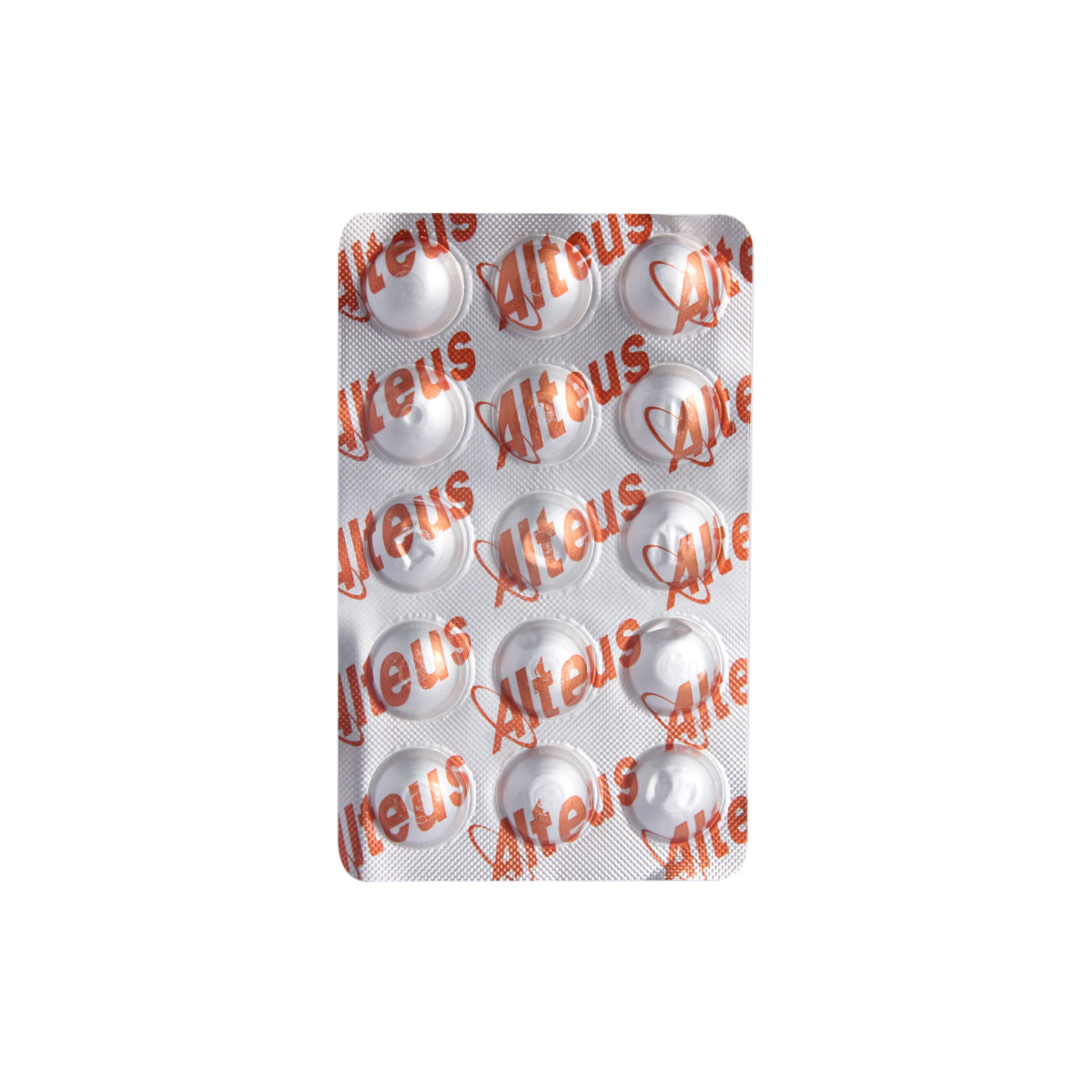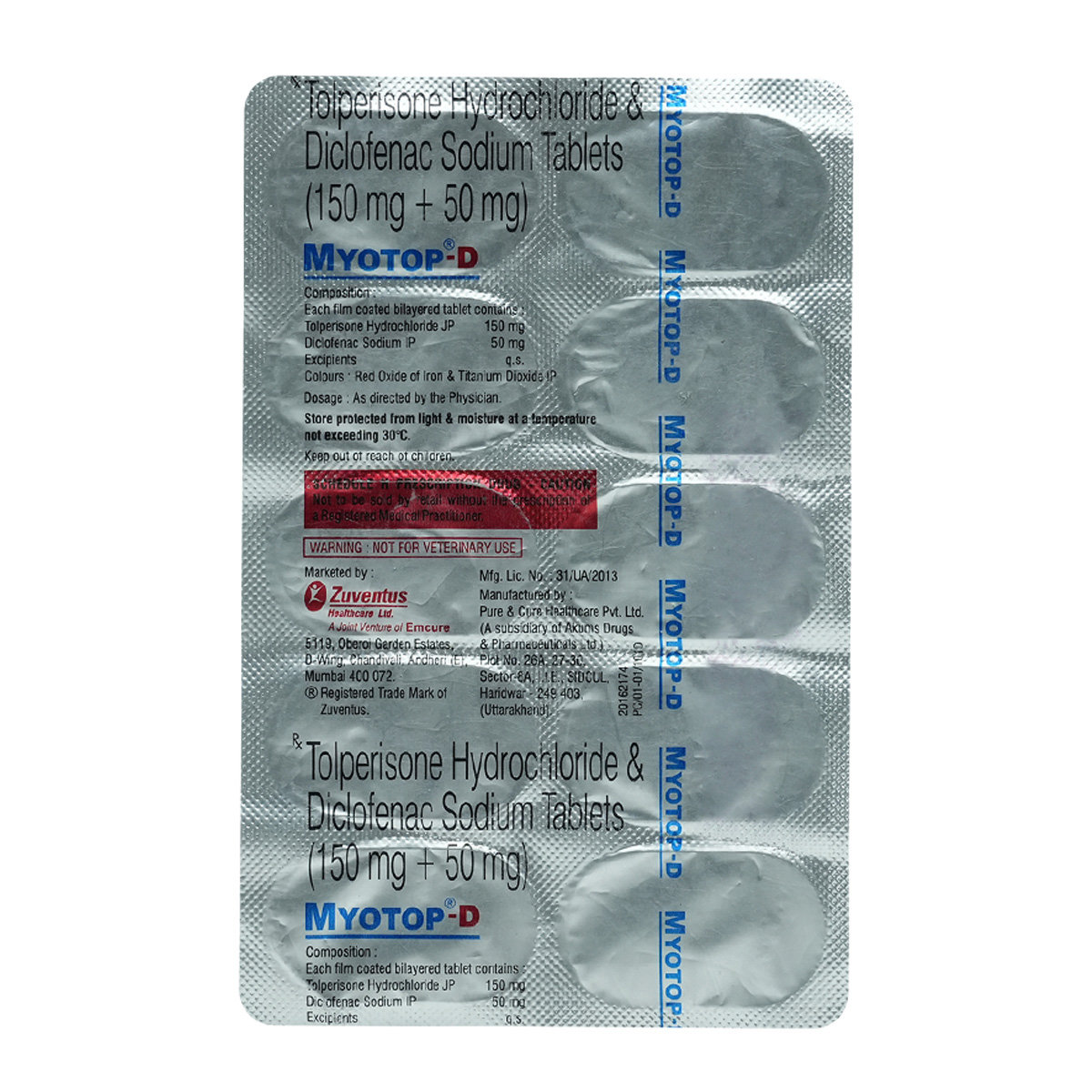Diclofenac+tolperisone
About Diclofenac+tolperisone
Diclofenac+tolperisone belongs to a class of medications called Non-steroidal anti-inflammatory drugs (NSAIDs) or pain killer. Diclofenac+tolperisone is used to reduce and relieve pain due to the muscle spasms (excessive tension in the muscles). Muscle spasm is the sudden involuntary contractions of the muscle, which can be painful and uncomfortable. When the nerve impulses that control the muscle movements are damaged or interrupted, it could lead to muscle spasms.
Diclofenac+tolperisone is a combination of two drugs, namely: Diclofenac and Tolperisone. Diclofenac is a pain killer (NSAIDs) while Tolperisone is a skeletal muscle relaxant. Diclofenac works by blocking the effect of a chemical messenger in your body, known as cyclo-oxygenase (COX) enzymes that make another chemical 'prostaglandins' (PG). These prostaglandins are produced at injury sites and cause pain and swelling. By blocking COX enzyme's effect, lesser PGs are produced, which reduces mild to moderate pain and inflammation at the injured or damaged site. On the other hand, Tolperisone works on the brain and spinal cord centres to relieve muscle stiffness or spasm and relieve pain and improve muscle's movement.
Take Diclofenac+tolperisone as prescribed by your doctor. You are advised to take Diclofenac+tolperisone for as long as your doctor has prescribed it for you depending on your medical conditions. You may experience nausea, diarrhoea, vomiting, heartburn, weakness, stomach pain/epigastric pain, sleepiness, dizziness, and appetite loss. Most of these side effects of Diclofenac+tolperisone do not require medical attention and gradually resolve over time. However, if the side effects are persistent, reach out to your doctor.
Diclofenac+tolperisone can increase your risk of fatal heart attack or stroke. So, if you have had any recent heart surgery, do not use Diclofenac+tolperisone. Diclofenac+tolperisone increases the chances of stomach ulcers and bleeding. Before taking this Diclofenac+tolperisone, inform your doctor if you have any allergies, myasthenia gravis (weakness in muscles), asthma, and hay fever. To treat your condition effectually, continue taking Diclofenac+tolperisone for as long as your doctor has prescribed. Do not take Diclofenac+tolperisone if you are pregnant or breastfeeding unless prescribed. Diclofenac+tolperisone causes drowsiness and dizziness, so drive with caution. Diclofenac+tolperisone should not be given to children as safety and efficacy have not been established. Avoid consuming alcohol along with Diclofenac+tolperisone as it could lead to increased drowsiness and dizziness, it might also increase the risk of stomach bleeding. Keep your doctor informed about your health condition and medicines to rule out any side-effects.
Uses of Diclofenac+tolperisone
Medicinal Benefits
Diclofenac+tolperisone belongs to a class of medications called Non-steroidal anti-inflammatory drugs (NSAIDs) or pain killers. Diclofenac+tolperisone is a combination of two drugs, namely: Diclofenac and Tolperisone. Diclofenac is a pain killer (NSAIDs) while Tolperisone is a skeletal muscle relaxant. Diclofenac works by blocking the effect of a chemical messenger in your body, known as cyclo-oxygenase (COX) enzymes that make another chemical 'prostaglandins' (PG). These prostaglandins are produced at injury sites and cause pain and swelling. By blocking COX enzyme's effects, lesser PGs are produced, which reduces mild to moderate pain and inflammation at the injured or damaged site. On the other hand, Tolperisone works on the brain and spinal cord centres to relieve muscle stiffness or spasm and relieve pain and improve muscle's movement. Altogether Diclofenac+tolperisone relieves pain and relaxes the muscles.
Directions for Use
Storage
Side Effects of Diclofenac+tolperisone
- Nausea
- Diarrhoea
- Vomiting
- Loss of appetite
- Heartburn
- Weakness
- Stomach pain/epigastric pain
- Sleepiness
- Dizziness
- Numbness and tingling
- Ringing in the ears
Drug Warnings
Diclofenac+tolperisone can increase your risk of fatal heart attack or stroke. So, if you have had any recent heart surgery, do not use Diclofenac+tolperisone. Do not take Diclofenac+tolperisone if you are allergic to Diclofenac+tolperisone, have severe heart failure, have suffered bleeding problems such as bleeding from stomach or bowels while taking any pain killers or you have liver or kidney problems. Inform your doctor before taking Diclofenac+tolperisone if you have or had high blood pressure, heart problems, high cholesterol, diabetes, asthma, liver and kidney problems. Do not take Diclofenac+tolperisone if you are pregnant or breastfeeding unless prescribed. Diclofenac+tolperisone causes drowsiness and dizziness, so drive only if you are alert. Diclofenac+tolperisone should not be given to children as the safety have not been established. Avoid consuming alcohol and Diclofenac+tolperisone as it could lead to increased drowsiness and increase the risk of stomach bleeding. Stop taking Diclofenac+tolperisone and consult your doctor immediately if you have stomach pain or any signs of bleeding in intestine or stomach such as blood in stools. Do not take any other NSAID's for pain relief along with Diclofenac+tolperisone unless prescribed. Keep your doctor informed about your health condition and medicines to rule out any side-effects.
Drug Interactions
Drug-Drug Interactions: Diclofenac+tolperisone may have interaction with anti-gout medicine (allopurinol, Probenecid), pain killers (aspirin), medicine for reducing immune system (cyclosporine), blood pressure-lowering medicine (furosemide), and medicines used in cancer (Methotrexate), other muscle relaxants (Methocarbamol)
Drug-Food Interactions: Avoid alcohol consumption while taking Diclofenac+tolperisone as it might cause increased dizziness and risk of stomach bleeding.
Drug-Disease Interactions: Diclofenac+tolperisone may have interactions with anaemia, muscle weakness, asthma, fluid retention, hyperkalemia (high potassium levels), heart, kidney, and liver problems.
Drug-Drug Interactions Checker List:
Safety Advice

Alcohol
unsafeAvoid consumption of alcohol while taking Diclofenac+tolperisone as it may increase dizziness. It can also increase the risk of stomach bleeding.

Pregnancy
cautionAvoid taking Diclofenac+tolperisone if you are pregnant unless prescribed by a doctor. Please consult your doctor if you have any concerns regarding this, your doctor will prescribe only if the benefits outweigh the risks.

Breast Feeding
unsafeDiclofenac+tolperisone must not be used during breastfeeding.

Driving
cautionDiclofenac+tolperisone may cause sleepiness or dizziness. Do not drive or do anything needing concentration until you know how it affects you.

Liver
unsafeThose who have severe liver problems should not take this Diclofenac+tolperisone because Diclofenac+tolperisone contains Tolperisone, which causes the most dangerous adverse in patients with liver disease.

Kidney
unsafeThose who have severe kidney problems should not take this Diclofenac+tolperisone because Diclofenac+tolperisone contains Tolperisone, which causes the most dangerous adverse in patients with kidney disease.

Children
unsafeDiclofenac+tolperisone should not be given to children as the safety and effectiveness were not established.
Habit Forming
Diet & Lifestyle Advise
- Exercising regularly helps in muscle stretching so that they are less likely to spasm, tear and sprain. Mild exercises such as jogging and walking are helpful for muscle stretching.
- Massages can also be helpful.
- Avoid freezing and hot temperatures.
- Avoid wearing tight-fitting clothes, instead, wear loose garments.
- Rest well, get plenty of sleep.
- To avoid developing pressure sores, change your position at least every two hours.
- Hot or cold therapy can help treat muscle spasms. Apply an ice-pack or hot-pack on the muscle for 15-20minutes.
- Stay hydrated, drink plenty of water.
Special Advise
- Applying ice pack to the affected area may help in relieving pain and inflammation.
- Avoid grapefruit juice.
Patients Concern
Disease/Condition Glossary
Pain is a symptom triggered by the nervous system, causing uncomfortable sensations in the body. Muscle spasm is the sudden involuntary contractions of the muscle, which can be painful and uncomfortable. When the nerve impulses that control the muscle movements are damaged or interrupted, it could lead to muscle spasms. Symptoms include muscle tightness, joint stiffness, unusual posture, difficulty moving, pain in affected muscles and joints. Fatigue (weakness), stress, extreme heat or cold, infection, and tight clothing can trigger muscle spasms. Muscle relaxants and exercise can treat muscle spasms. Muscle relaxants sedate the muscle and help in inhibiting painful contractions. Whereas, exercise helps in muscle stretching to be less likely to spasm, tear and sprain.
FAQs
Diclofenac+tolperisone is a combination of two drugs: Diclofenac (Nonsteroidal Anti-Inflammatory Drug) and metaxalone (skeletal muscle relaxant). Diclofenac works by blocking the action of certain chemical messengers that cause pain. Tolperisone works on the spinal cord and centres in the brain to relieve contraction or muscle stiffness without decreasing strength.
Diclofenac+tolperisone may impair mental and/or physical abilities required for the performance of heavy tasks like operating machinery or driving a motor vehicle, especially when used with alcohol.
Do not take Diclofenac+tolperisone for longer durations as it might increase the risk of heart problems, liver problems and stomach bleeding/ulcer. Please consult a doctor before its use.
There are no recognized reports of any patient getting addicted to Diclofenac+tolperisone.
If you are suffering from muscle pain due to overuse or muscle injury, you should take rest. Taking rest will help you to prevent any further injury and help you improve effectively. Make sure that you take enough sleep and try to decrease stress. Applying an ice pack to the altered area may help in reducing inflammation and pain. If your muscle pain is due to some other illness, follow the guidance of your doctor.
Take a missed dose as soon as you remember it. If it is close to the time for your next dose, skip the missed dose and go back to your regular time. Do not take 2 doses at the same time or extra doses.






